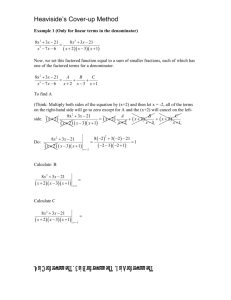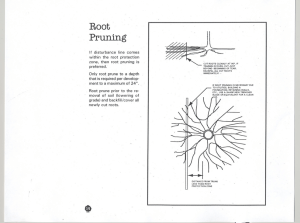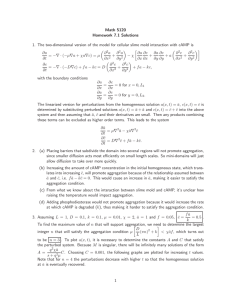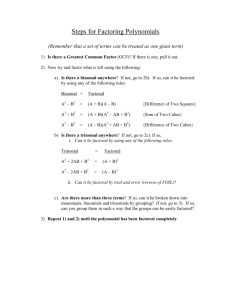An Approach to State Aggregation for POMDPs Zhengzhu Feng Eric A. Hansen
advertisement
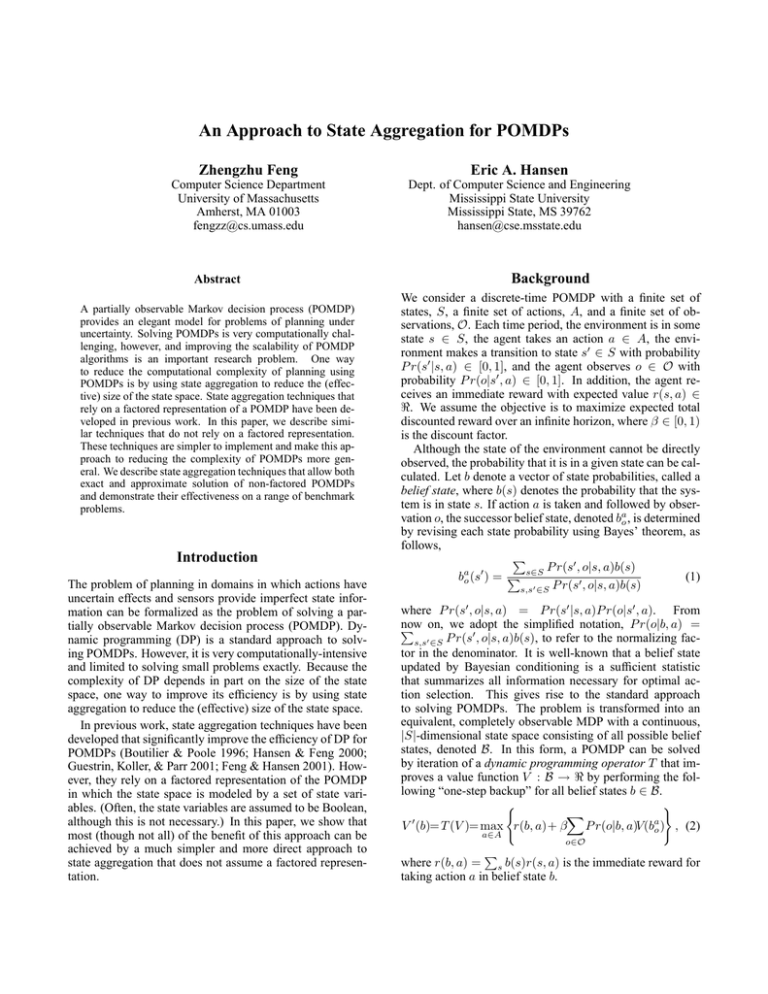
An Approach to State Aggregation for POMDPs
Zhengzhu Feng
Eric A. Hansen
Computer Science Department
University of Massachusetts
Amherst, MA 01003
fengzz@cs.umass.edu
Dept. of Computer Science and Engineering
Mississippi State University
Mississippi State, MS 39762
hansen@cse.msstate.edu
Background
Abstract
A partially observable Markov decision process (POMDP)
provides an elegant model for problems of planning under
uncertainty. Solving POMDPs is very computationally challenging, however, and improving the scalability of POMDP
algorithms is an important research problem. One way
to reduce the computational complexity of planning using
POMDPs is by using state aggregation to reduce the (effective) size of the state space. State aggregation techniques that
rely on a factored representation of a POMDP have been developed in previous work. In this paper, we describe similar techniques that do not rely on a factored representation.
These techniques are simpler to implement and make this approach to reducing the complexity of POMDPs more general. We describe state aggregation techniques that allow both
exact and approximate solution of non-factored POMDPs
and demonstrate their effectiveness on a range of benchmark
problems.
Introduction
The problem of planning in domains in which actions have
uncertain effects and sensors provide imperfect state information can be formalized as the problem of solving a partially observable Markov decision process (POMDP). Dynamic programming (DP) is a standard approach to solving POMDPs. However, it is very computationally-intensive
and limited to solving small problems exactly. Because the
complexity of DP depends in part on the size of the state
space, one way to improve its efficiency is by using state
aggregation to reduce the (effective) size of the state space.
In previous work, state aggregation techniques have been
developed that significantly improve the efficiency of DP for
POMDPs (Boutilier & Poole 1996; Hansen & Feng 2000;
Guestrin, Koller, & Parr 2001; Feng & Hansen 2001). However, they rely on a factored representation of the POMDP
in which the state space is modeled by a set of state variables. (Often, the state variables are assumed to be Boolean,
although this is not necessary.) In this paper, we show that
most (though not all) of the benefit of this approach can be
achieved by a much simpler and more direct approach to
state aggregation that does not assume a factored representation.
We consider a discrete-time POMDP with a finite set of
states, S, a finite set of actions, A, and a finite set of observations, O. Each time period, the environment is in some
state s ∈ S, the agent takes an action a ∈ A, the environment makes a transition to state s0 ∈ S with probability
P r(s0 |s, a) ∈ [0, 1], and the agent observes o ∈ O with
probability P r(o|s0 , a) ∈ [0, 1]. In addition, the agent receives an immediate reward with expected value r(s, a) ∈
<. We assume the objective is to maximize expected total
discounted reward over an infinite horizon, where β ∈ [0, 1)
is the discount factor.
Although the state of the environment cannot be directly
observed, the probability that it is in a given state can be calculated. Let b denote a vector of state probabilities, called a
belief state, where b(s) denotes the probability that the system is in state s. If action a is taken and followed by observation o, the successor belief state, denoted bao , is determined
by revising each state probability using Bayes’ theorem, as
follows,
P
P r(s0 , o|s, a)b(s)
bao (s0 ) = P s∈S
(1)
0
s,s0 ∈S P r(s , o|s, a)b(s)
where P r(s0 , o|s, a) = P r(s0 |s, a)P r(o|s0 , a). From
now
the simplified notation, P r(o|b, a) =
P on, we adopt
0
s,s0 ∈S P r(s , o|s, a)b(s), to refer to the normalizing factor in the denominator. It is well-known that a belief state
updated by Bayesian conditioning is a sufficient statistic
that summarizes all information necessary for optimal action selection. This gives rise to the standard approach
to solving POMDPs. The problem is transformed into an
equivalent, completely observable MDP with a continuous,
|S|-dimensional state space consisting of all possible belief
states, denoted B. In this form, a POMDP can be solved
by iteration of a dynamic programming operator T that improves a value function V : B → < by performing the following “one-step backup” for all belief states b ∈ B.
(
)
X
0
a
V (b)= T (V )= max r(b, a)+ β P r(o|b, a)V(bo ) , (2)
a∈A
P
o∈O
where r(b, a) = s b(s)r(s, a) is the immediate reward for
taking action a in belief state b.
The dynamic-programming operator is the core step of
value iteration, a standard algorithm for solving infinitehorizon POMDPs. Value iteration solves a POMDP by
repeatedly applying the dynamic-programming operator to
improve the value function. By the theory of dynamic programming, the optimal value function V ∗ is the unique
solution of the equation system V = T V , and V ∗ =
limn→∞ Tn V0 , where Tn denotes n applications of operator T to any initial value function V0 . A value function V
is said to be -optimal if ||V ∗ − V || ≤ . For any > 0,
value iteration converges to an -optimal value function after a finite number of iterations. A policy π : B → A can be
extracted from the value function as follows:
(
)
X
a
π(b) = arg max r(b, a) + β
P r(o|b, a)V (bo ) .
a∈A
o∈O
(3)
Because the dynamic-programming operator is performed
on a continuous space of belief states, it is not obvious
that it can be computed exactly. However, Smallwood and
Sondik (1973) proved that the dynamic-programming operator preserves the piecewise linearity and convexity of the
value function. A piecewise linear and convex value function V can be represented by a finite set of |S|-dimensional
vectors of real numbers, V = {v 0 , v 1 , . . . , v k }, such that the
value of each belief state b is defined as follows:
X
V (b) = max
b(s)v i (s).
(4)
i
v ∈V
s∈S
Moreover, a piecewise-linear and convex value function has
a unique and minimal-size set of vectors that represents
it. This representation of the value function allows the dynamic programming operator to be computed exactly. We
develop our state aggregation algorithm based on the incremental pruning (IP) algorithm (Cassandra, Littman, &
Zhang 1997). However our technique can be applied directly to more advanced algorithms such as region-based incremental pruning (Feng & Zilberstein 2004).
Like most other algorithms for computing the DP operator, IP essentially perform two tasks. The first is to generate sets of vectors that may be included in the updated value
function. The second is to prune these sets of vectors to their
minimal size, by removing dominated or extraneous vectors.
Of the two tasks, pruning takes by far the most computation
time. Cassandra et al. (1997) report that it takes 95% of the
computation time needed to solve a benchmark set of examples, and our experimental results are consistent with this.
Both tasks – generating and pruning vectors – can benefit
from state aggregation. However, the effect of state aggregation on improving the overall efficiency of the DP operator
is much greater in the pruning step because it takes most of
the computation time. In the rest of this paper, we describe
a method of state aggregation that can be performed in the
pruning step for non-factored POMDPs. This method provides most of the same benefit as methods that rely on a factored representation. Besides not requiring a factored representation, it is much simpler to implement and has lower
overhead.
Incremental pruning In their description of incremental
pruning, Cassandra et al. (1997) note that the updated value
function V 0 of Equation (2) can be defined as a combination
of simpler value functions, as follows:
V 0 (b)
=
V a (b)
=
max V a (b)
a∈A
X
V a,o (b)
o∈O
V a,o (b)
=
r(b, a)
+ βP r(o|b, a)V (bao )
|O|
Each of these value functions is piecewise linear and convex, and can be represented by a unique minimum-size set
of state-value functions. We use the symbols V 0 , V a , and
V a,o to refer to these minimum-size sets.
Using the script letters U and W to denote sets of statevalue functions, we adopt the following notation to refer to
operations on sets of state-value functions. The cross sum
of two sets of state-value functions, U and W, is denoted
U ⊕ W = {u + w|u ∈ U, w ∈ W}. An operator that takes
a set of state-value functions U and reduces it to its unique
minimum form is denoted PRUNE(U). Using this notation,
the minimum-size sets of state-value functions defined earlier can be computed as follows:
V0
Va
V a,o
= P RU N E (∪a∈A V a )
= P RU N E (⊕o∈O V a,o )
= P RU N E {v a,o,i |v i ∈ V} ,
where v a,o,i is the state-value function defined by
v a,o,i (s) =
X
r(s, a)
+β
P r(o, s0 |s, a)v i (s0 ),
|O|
0
(5)
s ∈S
Incremental pruning gains its efficiency (and its name) from
the way it interleaves pruning and cross-sum to compute V a ,
as follows:
V a = P RU N E(...P RU N E(V a,o1 ⊕ V a,o2 ) . . . ⊕ V a,ok ).
Table 1 summarizes an algorithm, due to White and
Lark (White 1991), that reduces a set of vectors to a unique,
minimal-size set by removing “dominated” vectors, that is,
vectors that can be removed without affecting the value of
any belief state. There are two tests for dominated vectors.
The simplest method of removing dominated vectors is to
remove any vector that is pointwise dominated by another
vector. A vector, u, is pointwise dominated by another, w,
if u(s) ≤ w(s) for all s ∈ S. The procedure POINTWISEDOMINATE in Table 1 performs this operation. Although
this method of detecting dominated state-value functions is
fast, it cannot detect all dominated state-value functions.
There is a linear programming method that can detect all
dominated vectors. Given a vector v and a set of vectors U
that doesn’t include v, the linear program in procedure LPDOMINATE of Table 1 determines whether adding v to U
improves the value function represented by U for any belief
state b. If it does, the variable d optimized by the linear program is the maximum amount by which the value function
procedure POINTWISE-DOMINATE(w, U)
for each u ∈ U
if w(s) ≤ u(s), ∀s ∈ S then return true
return false
procedure LP-DOMINATE(w, U)
solve the following linear program
variables: d, b(s) ∀s ∈ S
maximize d
subject to the constraints
bP· (w − u) ≥ d, ∀u ∈ U
s∈S b(s) = 1
if d ≥ 0 then return b
else return nil
procedure BEST(b, U )
max ← −∞
for each u ∈ U
if (b · u > max) or ((b · u = max) and (u <lex w)) then
w←u
max ← b · u
return w
procedure PRUNE(U)
W←∅
while U =
6 ∅
u ← any element in U
if POINTWISE-DOMINATE(u, W) = true
U ← U − {u}
else
b ← LP-DOMINATE(u, W)
if b = nil then
U ← U − {u}
else
w ← BEST(b, U)
W ← W ∪ {w}
U ← U − {w}
return W ‘
Table 1: Algorithm P RU N E for pruning set of state-value
functions U.
is improved, and b is the belief state that optimizes d. If it
does not, that is, if d ≤ 0, then v is dominated by U.
The P RU N E algorithm summarized in Table 1 uses
these two tests for dominated vectors to prune a set of
vectors to its minimum size. (The symbol <lex in the
pseudocode denotes lexicographic ordering. Its significance in implementing this algorithm was elucidated by
Littman (1994)).
State Aggregation
The linear program used to prune vectors has a number of
variables equal to the size of the state space of the POMDP.
The key idea of the state aggregation method is this. By
aggregating states with the same or similar values, the size
of the linear programs (i.e., the number of variables) can be
decreased. As a result, the efficiency of pruning – and so, of
DP – can be significantly improved.
procedure DP-UPDATE(V )
for each action a ∈ A
Va ←∅
for each observation o ∈ O
V a,o ← PRUNE({v a,o,i |v i ∈ V })
V a ← PRUNE(V a ∪ V a,o )
0
V ← PRUNE(∪a∈A V a )
return V 0
Table 2: Incremental pruning algorithm.
Algorithm State aggregation is performed by a partition
algorithm that takes as input a set of state-value functions
and creates an aggregate state space for it that only makes
the state distinctions relevant for predicting expected value.
Because an aggregate state corresponds to a set of underlying states, the cardinality of the aggregate state space can be
much less than the cardinality of the original state space. By
reducing the effective size of the state space, state aggregation can significantly improve the efficiency of pruning.
Table 3 describes the CREATE-PARTITION algorithm.
The algorithm starts with a single aggregate state that includes all states of the POMDP. Gradually, the aggregation
is refined by making relevant state distinctions. Each new
state distinction splits some aggregate state into smaller aggregate states. An aggregate state needs to be split when the
values of its states in a vector are not all the same. We split
the aggregate state by first sorting the states in it according
to their values, and then inserting elements in the L array
to indicate the new splitting point. The algorithm does not
backtrack; every state distinction it introduces is necessary
and relevant.
The following example will help to explain the algorithm.
We introduce a simple representation for a partition of the
state space, using two arrays I and L. I is a permutation of
the states, and L specifies the grouping of states in I.
Example Let S = {0, 1, 2, 3, 4, 5, 6, 7} be the set of
states. A partition that contains three aggregate states S0 =
{2, 0, 7}, S1 = {4, 5, 3, 1}, and S2 = {6} can be represented by I and L as follow:
I =
L =
[2, 0, 7, 4, 5, 3, 1, 6]
[−1, 2, 6, 7]
The set I is a permutation of the states. The set L specifies
the grouping of states in I. The number of aggregate states is
equal to |L| − 1. Each element except the last in L specifies
the index range in I that forms a group of states, so that:
Si = {I[L[i] + j] : 1 ≤ j < L[i + 1] − L[i]}
Note that index starts at 0. We use (I, L)i to denote the i-th
aggregate state in the partition defined by I and L.
Now suppose a new vector
s
v
0
1.0
1
3.0
2
1.0
3
3.1
4
3.0
5
3.1
6
2.0
7
1.0
is processed. This introduces inconsistencies in the partition
S1 , because states 1 and 4 have value 3.0, and states 3 and
procedure CREATE-PARTITION(V, α)
I ← [s0 , s1 , . . . , sn ]
L ← [−1, n − 1]
for each vector v ∈ V
L0 ← L
for i = 0 to |L| − 2
Sort the portion of I in (I, L)i according to v
b←1
for j = 2 to L[i + 1] − L[i] − 1
if |v(I[L[i] + j]) − v(I[L[i] + b])| > α
insert (L[i] + j − 1) in L0 after L[i]
b←j
L ← L0
return (I, L)
Table 3: Algorithm for partitioning a state set, S, into a set
of aggregate states, represented by (I, L), that only makes
relevant state distinctions found in a set of state-value functions, V.
5 have value 3.1. So the algorithm sorts states in S1 and
adds a split point at position 4, so that the new partition is
represented as follow:
I = [2, 0, 7, 1, 4, 3, 5, 6]
L = [−1, 2, 4, 6, 7]
The CREATE-PARTITION algorithm is called just before
any set of vectors is pruned. The pruning step is then performed on the abstract (or aggregate) state space produced
by the algorithm.
Complexity The most expensive operation in the algorithm is sorting, which takes time O(|Si | log |Si |) where |Si |
is the size of a partition being sorted. Note that the size of the
partition is the reciprocal of the number of partitions, so the
sorting time needed to process each vector can be bounded
by O(|S| log |S|). Thus the worst-case running time of the
partition algorithm is O(|V||S| log |S|). As we can see in
the experimental results, this running time is negligible compared to the running time of the DP algorithm.
Approximation
The partition algorithm also takes a second parameter, α,
that allows approximation in the state aggregation process.
When α = 0, an aggregation that preserves exact values is
created. When α > 0, states with similar but not necessarily
the same values are grouped together, and assigned a similar
value. In the above example, if α is set to 0.1, then partition
S1 does not need to be split.
We note that approximation error can be bounded in the
same way described by Feng and Hansen (2001), who assume a factored representation of the POMDP. Their analysis extends directly to our algorithm. We list below two
important theorems regarding the approximation:
Theorem 1 (Error bound) The error between the current
and optimal value function is bounded as follows,
kT̂n V − V ∗ k ≤
β
δ
kT̂n V − T̂n−1 V k +
,
1−β
1−β
where δ = α · (2|O| + 1) denotes the approximation error.
Theorem 2 (Convergence) For any value function V and
ε > 0, there is an N such that for all n > N ,
kT̂n V − T̂n−1 V k ≤
2δ
+ ε.
1−β
Computational Results
Factored problems We first tested our algorithm on problems that have a factored representation, in order to compare its performance to the factored algorithm of Hansen and
Feng (2000). We used problems 3, 4 and 5 (denoted HF3,
HF4, HF5) from their paper as test problems. Problem 3 is a
widget-processing problem originally described in (Draper,
Hanks, & Weld 1994). Problem 4 is an artificial worst-case
example in the sense that there is little structure in the problem that allows state aggregation. Problem 5 is an artificial
best-case example where there are many similar state values,
allowing significant state aggregation.
Table 4 shows some timing results. For the three HF examples, it compares one step of value iteration using three
different algorithms: our state aggregation algorithm, the
state aggregation algorithm that relies on a factored algorithm, and no state aggregation at all. For each problem, the
result without state aggregation is shown at the top. Below it
is the result of the factored algorithm, and below that is the
result of our new state aggregation algorithm. All programs
take the same input and compute identical results. They perform the same number of backups and the same number of
pruning operations, and they solve the same number of linear programs. The difference between our algorithm and the
factored algorithm is that our algorithm uses a much simpler
and more general approach to state aggregation that does not
rely on a factored representation.
From the timing results for the pruning operation, which
is the most expensive step in DP, we can see that our state
aggregation algorithm provides the same level of speed-up
as the factored algorithm, when state aggregation is possible. Note that the pruning time in the table includes the time
used to create an aggregate state space using the CREATEPARTITION procedure. As we can see, state aggregation
usually take less than 1% of the pruning time, and never
takes more than 3% in any case. Compared to the factored
algorithm, our state aggregation technique is faster in creating a partition, because we use a simpler data structure that
requires less overhead.
For the worst-case example, where state aggregation is not
possible, our algorithm spends slightly more time on pruning than the other algorithms. The reason for this slight difference is that our aggregation algorithm re-arranges the order of the states in the vectors, and the actual setup of the
linear programs (the order of variables and constraints) can
affect the solving time.
For the backup step, we see that our algorithm takes about
the same amount of time as the algorithm that does not perform state aggregation, and is usually slower than the factored algorithm. This is because our algorithm does not exploit state abstraction in the backup step, whereas the factored algorithm does. However, as we can see from the ta-
Timing Results
HF3
26
HF4
6
HF5
cit
pentagon
2
7
2
284
212
Abs
7.5
64.0
12.8
44.0
44.8
Back
1.1
0.7
1.2
53.5
404.0
54.0
7.7
5.7
8.3
4.5
4.6
114.7
124.4
Part
0.6
0.0
1.8
0.6
3.8
1.0
1.5
6.1
Prune
5.5
3.4
2.7
8127.8
8244.4
8747.1
146.3
35.3
29.0
139.7
67.3
681.6
293.8
680
Total
6.7
4.0
4.0
8181.9
8653.2
8801.8
154.2
41.4
37.6
144.5
73.7
796.3
418.3
640
620
600
580
560
540
520
500
480
460
0
100
200
300
400
CPU time (seconds)
300
500
600
exact
approximate
250
# Aggregate states
Table 4: Timing results (in CPU seconds) for one iteration of
DP. The column with the heading “Abs” represents the mean number of abstract states created by the aggregate and factored algorithms, which is averaged over all calls to the procedure PRUNE.
“Back” represents the time for computing new vectors. “Part”
represents the time for partitioning the state space into aggregate
states. “Prune” represents the time for pruning vectors using linear
program pruning.
exact
approximate
660
Error bound
Prune
Ex.
|S|
200
150
100
50
ble, 95% or more of the running time of DP is devoted to
the pruning step (except for problem HF3, which is about
82%). Therefore, the advantage enjoyed by the factored
algorithm in the backup step is not significant in the overall performance of the algorithm. It is interesting to note
that for the worst-case example, the factored algorithm spent
about 5 times more time in the backup step. This is due to
the overhead of manipulating the complex decision diagram
data structure, which can be significant when there is little
or no structure in the problem.
Figure 1: Performance of value iteration using state aggregation,
Non-factored problems Next we tested our algorithm on
two robot navigation problems, cit and pentagon, described
in (Cassandra, Kaelbling, & Kurien 1996). These two examples cannot be naturally represented in factored form. We
can compare the performance of our algorithm only to the
basic algorithm that does not use state aggregation, because
the factored algorithm cannot be applied to these problems.
In the corresponding entries in Table 4, the top line shows
the timing results for the basic algorithm and the bottom
line shows the results for the new state aggregation algorithm. It shows that the pruning step can benefit from state
aggregation, even for problem that do not have a factored
representation.
approximation in early iterations of value iteration, as of way
of speeding convergence.
For example, we implemented a scheme that gradually reduces the approximation error in the state aggregation process, similar to the scheme described in (Feng & Hansen
2001). Figure 1 shows the effect of approximation on the
cit problem. In the bottom graph, we see that approximation
allows more state aggregation than the exact algorithm. This
makes it possible to perform more iterations of the DP algorithm, and to reduce the error bound of the value function
further than is possible in the same amount of time, using
the exact algorithm.
Approximation We point out again that these timing results are for one iteration of the DP algorithm only. Over
successive iterations of the algorithm, the degree of abstraction can decrease as the value function is refined. To counteract this, approximation can be introduced to maintain a
similar degree of state abstraction. It is also possible to use
We have presented a simple approach to state aggregation
for POMDPs that does not depend on a factored representation, yet retains most of the benefits of the factored algorithms developed before. These benefits include the ability
to exploit problem structure in order to reduce the effective
size of the state space, and the ability to use approximation
0
0
100
200
300
400
CPU time (seconds)
500
600
with and without approximation. Each point represents data at the
end of an iteration. The top graph shows the error bound at each
iteration, and the bottom graph shows the average number of aggregated states at each iteration. Note that value iteration with exact
state aggregation did not finish the last iteration after 600 seconds.
Conclusion
to reduce state space size further, in order to improve the
scalability of POMDP algorithms.
Acknowledgments We thank the anonymous reviewers
for helpful comments. This work was supported in part
by NSF grant IIS-9984952 and IIS-0219606, NASA grant
NAG-2-1463, and AFOSR grant F49620-03-1-0090. Any
opinions, findings, and conclusions or recommendations expressed in this material are those of the authors and do not
reflect the views of the NSF, NASA, or AFOSR.
References
Boutilier, C., and Poole, D. 1996. Computing optimal
policies for partially observable Markov decision processes
using compact representations. In Proceedings of the 13th
National Conference on Artificial Intelligence (AAAI-96),
1168–1175.
Cassandra, A. R.; Kaelbling, L. P.; and Kurien, J. A. 1996.
Acting under uncertainty: Discrete bayesian models for
mobile robot navigation. In Proceedings of IEEE/RSJ International Conference on Intelligent Robots and Systems.
Cassandra, A.; Littman, M.; and Zhang, N. 1997. Incremental pruning: A simple, fast, exact method for partially
observable markov decision processes. In Proceedings of
the 13th International Conference on Uncertainty in Artificial Intelligence.
Draper, D.; Hanks, S.; and Weld, D. 1994. Probabilistic
planning with information gathering and contingent execution. In Proceedings of the Second International Conference on Artificial Intelligence Planning Systems.
Feng, Z., and Hansen, E. 2001. Approximate planning
for factored POMDPs. In Proceedings of the 6th European
Conference on Planning.
Feng, Z., and Zilberstein, S. 2004. Region-based incremental pruning for POMDPs. In Proceedings of the 20th
Conference on Uncertainty in Artificial Intelligence (UAI2004).
Guestrin, C.; Koller, D.; and Parr, R. 2001. Solving factored POMDPs with linear value functions. In Proceedings of the IJCAI-2001 workshop on Planning under uncertainty and incomplete information.
Hansen, E., and Feng, Z. 2000. Dynamic programming
for POMDPs using a factored state representation. In Proceedings of the 5th International Conference on Artificial
Intelligence Planning and Scheduling.
Littman, M. 1994. The witness algorithm: Solving partially observable markov decision processes. Brown university department of computer science technical report cs94-40.
Smallwood, R., and Sondik, E. 1973. The optimal control of partially observable markov processes over a finite
horizon. Operations Research 21:1071–1088.
White, C. 1991. A survey of solution techniques for the
partially observed markov decision process. Annals of Operations Research 32:215–230.
